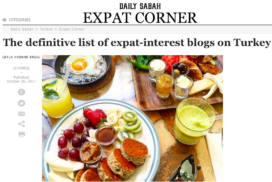
In my research to figure out the best way to bind my watercolour journals, I’ve been watching lots of videos and scanning Amazon to find the best book binding equipment and materials for beginning book binders. This is just the start of my research, but it’s more than enough to be getting on with.
DIY Mini Watercolor Journal Video
This mini art journal is from Letters of Meeya channel. It shows the step-by-step instructions really clearly, and I especially liked the close up view of the Kettle Stitching technique.
The binding is done in such a way that it mirrors a traditional book, where the contents are attached to the spine using a pair of wings that are pasted to the contents and then glued to the back and front, and covered with the same paper used for the outside.
My only concern with this design is that it may not lay very flat, and that’d be key if you’re going to paint on both sides of each page. It’s the glueing of the pages that would stop it laying flat, but also the way the cover extends across the spine. But I’m wondering if you can not glue the spine, and still have the full-back cover.
Double Needle Coptic Stitch Bookbinding
The bookbinding only has front and back panels, but based on my competitive research on Etsy, most of the art journals are made this way.
Using the Coptic Stitch and not gluing the edges means that each page will lay flat, which I think is essential for my art journal books.
Materials I need to invest in:
- Binder’s Board (chipboard).
- Elmer’s E4019 CraftBond(R) All-Purpose Glue Stick, Clear – Extra Strength
- Healifty 6pcs Screw Hole Punch Leather Tool Book Drill Craft Paper Punch Kit 6 Tips 1.5mm 2mm 2.5mm 3mm 3.5m 4mm (makes the holes in the chipboard nicely and cleanly. (Gotta have this!)
- Set of 16 Bookbinding Tools
- Wax Leather Thread
- 1oz Yellow Beeswax Bar
- Stainless Steel Ruler
- 4-Inch Rubber Brayer Roller for Printmaking, Great for Gluing Application – to get rid of air bubbles
French Link Stitch Bookbinding Video
This French Link stitch is easy enough to do, and if you’re creating an exposed spine design, it adds a little bit of extra pizzaz. For the size I’m planning, my books would only have two sets of French Links and two rows of traditional Kettle Stitch.
The video has a good close up explanation of the Kettle Stitch, so to create these two rows of two – I’d need 6 holes. Ok for a portrait book with the long side being 6 inches, but for a landscape book it wouldn’t work, because that side would only be 4 inches. But maybe I could use one set of French links and two rows of Kettle Stitch.
What I like about this design, is that Jennifer’s actually stitched and front and back cover onto this book. It’s a lightweight card cover, which is just folded the same way as one of the pages. It’s not sturdy enough for a travel art journal, but Jennifer said it’s possible to glue a board cover directly onto these card covers. If I were going to do this design, I’d glue the folded card covers together (both the front one and the back one, to make it sturdy, and then glue the board cover onto it. This would make a really sturdy book, that has an exposed spine and lays flat. Jennifer also says that this stitch keeps the book a bit more rigid that just using a Kettle Stitch.
Why use the French Stitch?:
- Lays flat so good for Journaling and Sketching or Painting
- Provides Extra Stability than the long stitch
- It’s beautiful so works well to be an exposed stitch.
To create this look you need an EVEN number of holes in your signature.
Using Tape with French Link Stitch
Bookbinding: Kettle Stitch Text Block
What I like about this video is that once you’ve gone along your signature (stack of paper), you go back the other way so that the thread goes in and out of the same hole to create a continuous line of stitching on the inside of your book.
On the second row you loop your thread through the thread on either side of the hole on the first signature (up and then down). Then thread your needle through the same hole on your second signature to create your Kettle Stitch.
To create this look you need an ODD number of holes in your signature.
It seems like this approach would be a bit sturdier than starting your Kettle Stitch when you’ve only gone one way along the book (if you’d had an Even number of holes in your signature). When you go one way and go back the other, you complete the loop of thread. It’s a tidier and more professional look.
The first signature would have a continuous line of stitching on the outside but the others would just have a Kettle stitch on them.
If you’re
Want to start bookbinding your own art journals? Here's some videos showing different stitches and varying methods of affixing a cover to your homemade books. Click To Tweet















